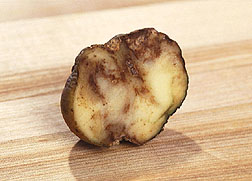This page has been archived and is being provided for reference purposes only. The page is no longer being updated, and therefore, links on the page may be invalid.
|
Kitchen Meets Farm in Fight Against Late Blight
By Erin PeabodyMarch 13, 2006
Fine chefs may wince, but scientists with the Agricultural Research Service (ARS) are reaching into the cupboard and finding unconventional uses for such culinary classics as oregano and thyme, testing the herbs’ potency in a messy battle out on the farm.
ARS plant pathologist Modesto Olanya and colleagues are investigating plant essential oils—including oregano, thyme and lavender—and other biologically based approaches to control one of the most devastating potato diseases worldwide: late blight. Potato plants infected with the fungal spoiler, called Phytophthora infestans, may be rapidly defoliated and destroyed.
The fungal disease, blamed for the Irish potato famine of the 1840s, is a formidable disease to fend off. It quickly gains resistance to widely used systemic fungicides, requiring researchers to constantly search for new ways to protect America’s favorite vegetable from the fungal threat.
Olanya, who works at ARS’ New England Plant, Soil and Water Research Laboratory in Orono, Me., has found that among the essential oils, oregano is showing the greatest promise as a late blight suppressor. In laboratory tests, the Maine researchers found that oregano and other essential oils greatly inhibited the growth of P. infestans fungi. However, oregano was less effective in suppressing late blight in growth chamber studies than in the laboratory.
If future studies continue to show promise, natural remedies such as essential oils could someday reduce a portion of the many fungicides used to prevent late blight from taking root in U.S. potato fields each year. To increase their efficacy, Olanya is looking at pairing essential oils with other natural products, such as beneficial microorganisms.
The essential oils do have some limitations to overcome. According to Olanya, oregano is fairly volatile, meaning some of its fungi-fighting essence could evaporate from plant surfaces after it’s been applied. Conversely, the oils can burn plant leaves if applied too generously.
ARS is the chief scientific research agency of the U.S. Department of Agriculture.

